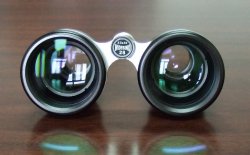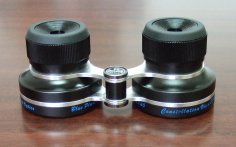


An opera glass? What is it good for? For the opera? Perhaps, yes, but not exclusively. There are other interesting applications for such an instrument, if it is made properly and performing well.
Fig. 1: The 2.3x40 opera glass
The model to be presented here is one of these binoculars which are interesting because it is so different from the mainstream. This one is quite big, with 40mm objective lenses, and well built, lots of metal and a respectable weight of 280 g. Most impressive is its field of view, specified as almost 500m/1000m or 28 degree. Apparently, there once existed a Russian model of the same style which is nowadays out of production. These glasses are now made in China and seem to be quite popular in Japan. My sample has got the "Blue Planet Optics" imprint of the corresponding US dealer. According to a Japanese site, this glass even accepts M48 filters (see bottom of this page for links).
Well, in real life it is not possible to make use of the entire field of view. In my experience, the actual field of view is somewhere between 20 and 25 degree, depending on how hard one is pushing the eyepiece into the eye-socket.
Like all opera glasses, this one is of Galilei type, i.e. there exists no intermediate image between objective and ocular and no prisms are required to reverse the image. In this case, the field of view is determined by the size of the objective, which explains the choice of those large 40mm diameter lenses. According to a sketch of this binocular which I saw on a Japanese web-page I assume that the objective design is of the Gauss-type, i.e. an air spaced doublet which has contact at the center. The oculars are formed of a thick cemented doublet. Since this ocular is essentially a negative lens, there exists no exit pupil of the type found in usual prism binoculars. This is so because such an ocular creates just a virtual image of the objective (more precisely: the aperture stop) which is located between objective and ocular, and no real image outside the ocular. The official specification of "7mm eye-relief" therefore appears meaningless since there exists no exit pupil outside the ocular whose distance could be measured. Instead, there is a plastic plate covering the ocular lens with a clear aperture of about 8mm, just above the maximum size of an eye-pupil in a dark night. It has been reported that a removal of this plate would allow to see over the entire 28 degree field of view. As is the case with all Galilei type binoculars, their magnification depends on the focusing distance. When focusing close, it is increasing. I assume that the official specification of 2.3x refers to the infinity setting.
 Fig. 2: Lens edges produce stray light
Fig. 2: Lens edges produce stray light
This binocular is reasonably well coated, much better than most of the opera glasses found else on the market. When viewing through the ocular, the edge of field is fuzzy and covered by a diffuse stray light. As can easily be seen when looking through the objectives, some of the lenses have got glossy edges which reflect into the light path to contribute to the stray light (Fig. 2). One might better apply some black paint to the lense edges to eliminate that problem.
Under the night sky, many of the star constellations are fitting entirely into the field of view. At only 2.3x magnification, this binocular acts as a kind of booster, which allows to see between one and two magnitudes deeper than the naked eye. It is therefore very useful to locate objects which are just near the limiting magnitude for the naked eye, and under dark skies the number of stars seen through these little opera glasses is very impressive. It is important to point out that the star images are quite good even towards the edge of the field. It seems at just 2.3x the eyes can still compensate for the field curvature so that stars remain point-like over the major part of the image. However, one has to make sure to keep it properly aligned, i.e. not to cant or tilt it during observation, since that would immediately generate a visible amount of coma around the star images.
In summary, this is an interesting small glass which every astronomer might want to carry inside his gadget-box. Even under poor viewing conditions, e.g. under light polluted skies near the cities, this booster allows to identify star constellations which were otherwise only seen from remote and dark locations. The current price of roughly 100 US$ appears reasonable to me. This binocular can be improved no doubt: Apply some black paint to reduce the stray light which is produced at the lens edges, and remove or modify the plastic plates which cover the oculars, so that the eye could come closer to the eye-lens and the entire field of view can be seen over.
Blue Planet Optics, US Dealer for 2.3x40
Kasai Trading, Japanese Dealer for 2.3x40
Review of the 2.3x40 on Cloudy Nights
Holger Merlitz: merlitz@gmx.de
Last updated: June 2008